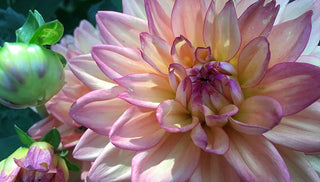There are shrinking violets and then there are dahlias, which are nothing if not flamboyant. Their flowers can range from dinnerplate size to petite pompoms. Native to the Andes of South America, this daisy-family plant is a tender perennial in most areas of the country, but is hardy outdoors in USDA zones 8 to 10. In zone 7, they can survive winters with a thick layer of protective mulch.
Choosing Dahlias
Horticulturists have divided dahlias into 10 classifications, with numerous subcategories and fine distinctions. Because there are so many varieties, choosing dahlias is much more difficult than growing them. However, you can put dahlias into three broad groups: large, medium and small:
Large dahlias range from about 3 to 4 feet tall. The most well-known dahlias in this size range are dinnerplate dahlias, known for their 10- to 12-inch-diameter double flowers. These are best grown in the back of perennial borders with other large perennials. They put on a stunning late-summer and early-fall show, but will require some kind of support to withstand summer winds and rain. Try thick bamboo stakes or whimsical spiral supports.
Medium dahlias, also known as border dahlias, are compact 1- to 2-foot-tall plants. These dahlias look great in the front of a perennial bed mixed with other late-blooming perennials, such as phlox and asters. In addition, all border dahlias can be grown in containers. For something different, consider cactus-flowered dahlias, which have distinctive rolled petals.
Small dahlias are perfect for windowboxes. These 10- to 20-inch plants bloom for a long time and remain fairly compact. You can also use them at the edge of a border or in pots and planters.
 Dahlia tubers should be firm and plump.
Dahlia tubers should be firm and plump.How to Plant Dahlias
Dahlias grow and flower best in a well-drained, sunny site. They like warm weather and will not tolerate frost. Plant dahlia tubers outdoors after your last frost date, when the soil has warmed. Most dahlias will begin flowering by midsummer.
If you live in a cold climate and want to get an early start, you can start your dahlia tubers in 1-gallon pots about two to four weeks before your last frost date. Once they've sprouted, place the pots under grow lights or in front of a sunny window (a south-facing window is best). After danger of frost has passed, transplant them gently into their garden location.
To plant all but the diminutive-sized dahlia types, dig a 6- to 12-inch-deep hole and amend the soil with compost. If the soil drains poorly, mix in some fine gravel. Backfill the hole with native soil and plant the tubers 2 to 4 inches deep, and about 1 to 3 feet apart, depending on the variety. Growth begins in 14 to 20 days.
Tall varieties, such as dinnerplate dahlias, will need support or staking to keep the heavy blooms from falling over. Our Rainbow Spiral Supports are a fun addition to the garden and will be quickly covered by lush foliage. Or use any type of flower support. Just make sure to put the supports in place before the plants get large. To create a bushier plant, pinch off the top growth of the dahlia shoots above the third set of leaves while plants are still young. Shorter varieties are naturally bushier and won't need pinching.
Summer and Fall Care
Fertilize dahlias monthly with a water-soluble, organic fertilizer that's formulated for flowers. Avoid using a high-nitrogen fertilizer, or you'll get lots of green growth with little flowering. Mulch with straw or shredded bark to keep weeds to a minimum and retain moisture. Water regularly, especially during dry periods. Cut blossoms for indoor flower arrangements and remove old blossoms to encourage more branching and flower production. Despite a relatively short vase life, dahlias make gorgeous bouquets.
Overwintering
Dahlias are tender annuals, but you can overwinter them pretty easily. In fall, after the first frost has blackened the foliage, cut off all but 2 to 4 inches of top growth, and carefully dig tubers without damaging them. Allow tubers to dry for a few days in a frost-free location, out of direct sunlight. Once dried, remove any excess soil, leaving 1 to 2 inches of stem. Store each clump of tubers in a ventilated box or basket. Fill the box with slightly moistened sand, peat moss or vermiculite and place it in a cool, dry location with temperatures that remain between 45 and 55 degrees F. Check tubers periodically through winter for rotting and drying out. If the tubers appear shriveled, mist them lightly with water. If any start to rot, trim the rotted portion of the clump so it won't spread. The tubers are fragile, so be careful when handling them.
When warm weather arrives, you can plant the overwintered tubers and begin the cycle again.


 Gathering dahlias in our
Gathering dahlias in our


